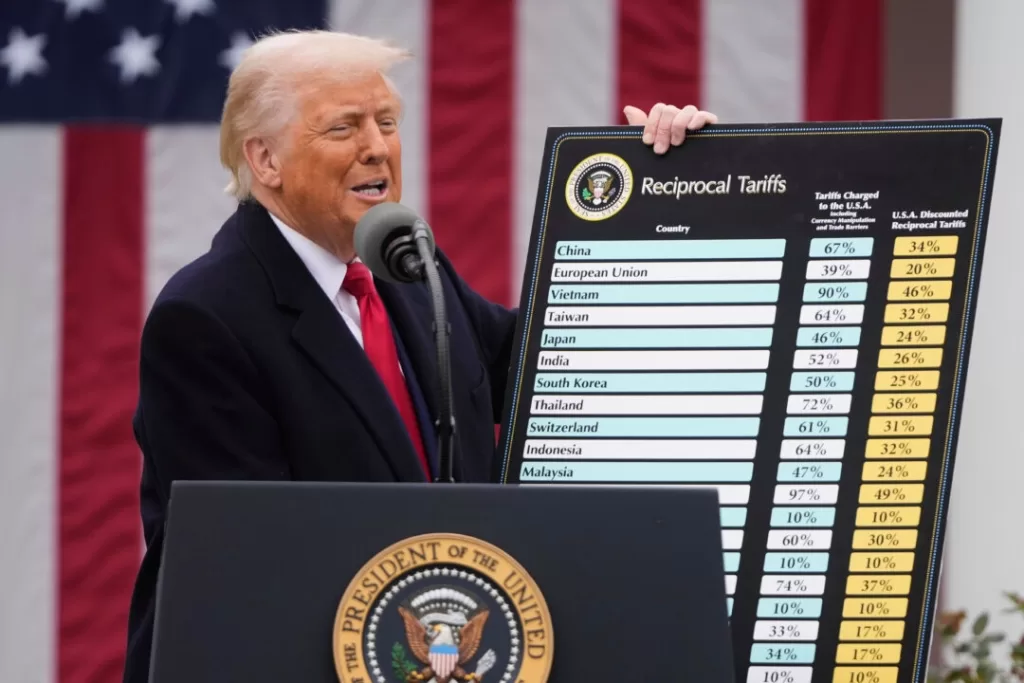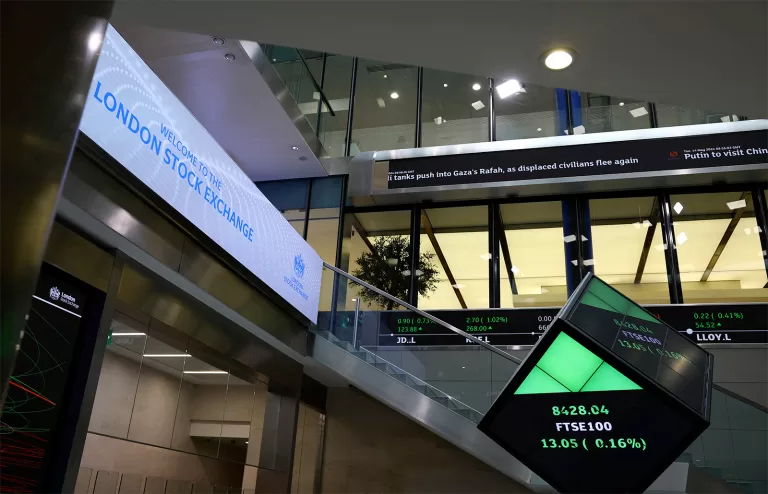
WASHINGTON, D.C.—In a seismic shift to U.S. trade policy, President Donald Trump announced sweeping tariffs on April 2, marking what he called “Liberation Day in America.”
Just 72 days into his second term, Trump unveiled a comprehensive tariff regime designed to reshape global commerce. Under the new policy, the United States will impose a universal 10 percent import tariff on all goods, alongside steep reciprocal levies on trading partners with high trade barriers against American exports.
The move dismantles decades of U.S. commitment to low tariffs and free trade agreements, signaling a protectionist shift aimed at revitalizing domestic manufacturing and reducing America’s trade deficit.
Standing beside a massive chart detailing the new tariff rates, Trump declared:
“Foreign nations will finally be asked to pay for the privilege of access to our market—the biggest market in the world.”
While the administration touts the tariffs as a strategy to boost American jobs and industrial growth, economists warn of potential inflationary pressures and market volatility. Here are the key takeaways from the announcement.
Across-the-Board 10% Import Tariff Takes Effect April 5
The baseline 10 percent tariff applies to all imports, regardless of origin. It will take effect at 12:01 a.m. on April 5.
Trump invoked the 1977 International Emergency Economic Powers Act to enforce the measure, citing a national economic emergency. The White House estimates the tariffs could generate trillions of dollars in revenue over the next decade.
Reciprocal Tariffs Target Nations With High Trade Barriers
Beyond the universal tariff, the administration is introducing additional tariffs on nations with restrictive trade practices against U.S. goods. These “reciprocal tariffs” are designed to counteract foreign protectionist policies, such as excessive value-added taxes (VATs), currency manipulation, and non-tariff barriers that make it difficult for U.S. companies to compete abroad.
Countries facing significant reciprocal tariffs include:
- European Union – 20%
- Japan – 24%
- South Korea – 25%
- Taiwan – 32%
- India – 34%
- Vietnam – 46%
- China – 34% (bringing total tariffs on Chinese imports to 54%)
“We’re kind people, very kind,” Trump said. “We’re only charging half of what they charge us.”
The reciprocal tariffs take effect on April 9 at 12:01 a.m.
China Faces Sharpest Tariff Increases
The United States’ largest trade deficit remains with China, which totaled nearly $300 billion last year. Trump has long accused Beijing of engaging in intellectual property theft, forced technology transfers, and state subsidies that undermine U.S. businesses.
In his previous term, Trump imposed a 20 percent tariff on all Chinese imports, citing national security concerns over fentanyl trafficking—a drug crisis linked to Chinese chemical exports.
With the new 34 percent reciprocal tariff added to existing levies, China’s total tariff rate now soars to 54 percent, approaching the 60 percent Trump floated during his campaign.
White House officials also flagged concerns over China’s use of third-party nations, including Vietnam and Thailand, to evade tariffs through transshipping.
“The problem with Vietnam is not their tariffs,” one official noted. “The problem is that they’re serving as a backdoor for communist China.”
Economists suggest China will be the least likely to yield to Trump’s trade policies, raising the prospect of a prolonged economic standoff.
Canada and Mexico Excluded—For Now
Conspicuously absent from the new tariff regime are Canada and Mexico.
The White House confirmed that the existing 25 percent tariffs on both nations—originally imposed over concerns about illegal immigration and fentanyl trafficking—will remain in place.
However, Canada and Mexico could eventually be integrated into the new tariff structure if their border security and trade practices remain unchanged.
“At this time, Canada and Mexico remain subject to the national emergency related to fentanyl and migration,” a senior official stated.
Canada’s Prime Minister Mark Carney has vowed retaliation, calling Trump’s tariffs a “fundamental attack on the international trading system.”
Trump’s Justification: ‘Making America Wealthy Again’
Trump framed the tariffs as a long-overdue correction to decades of economic exploitation by foreign powers.
“For 50 years, our country has been looted, pillaged, and plundered,” he declared. “Foreign cheaters have ransacked our factories, torn apart our American dream, and left our workers behind.”
Since the passage of NAFTA in 1994, the U.S. has lost over 5 million manufacturing jobs while accumulating a $19 trillion trade deficit—a trend Trump aims to reverse.
His administration argues that chronic trade deficits are not just an economic issue but a national security crisis.
“This is not a negotiation,” a senior White House official stated. “It’s a national emergency.”
Will Tariffs Trigger a Recession? Economists Disagree
Financial markets reacted sharply to the announcement. The S&P 500 dropped 4.6 percent in Q1, while NASDAQ fell 10 percent—the worst quarterly performance since 2022.
Goldman Sachs raised the likelihood of a U.S. recession to 35 percent, citing tariff-driven uncertainty.
Yet some economists argue that fears of economic collapse are overstated.
“U.S. exports account for 11% of GDP, and imports—deducted from GDP—make up 14%,” said economist William Lee of the Milken Institute. “This is not enough to trigger a global depression.”
Others, like Ian Fletcher, caution that the tariffs could shock the market, potentially leading to a sharp economic contraction.
“Trump has gone far beyond what he did in his first term,” Fletcher noted. “A phased approach would have been less disruptive.”
Key Economic Indicators to Watch:
- Employment rates and real income growth – early signs of the tariffs’ impact on American workers.
- U.S. manufacturing investment trends – a key measure of whether the tariffs succeed in reshoring production.
- Inflation levels – if higher prices persist, tariffs could fuel broader economic instability.
The Road Ahead
Trump’s latest trade policies mark a bold, if contentious, gamble. While supporters hail them as a necessary course correction, critics warn of inflation, supply chain disruptions, and global retaliation.
As these tariffs take effect, America’s economic trajectory—and its place in the global trade system—will face a pivotal test.






